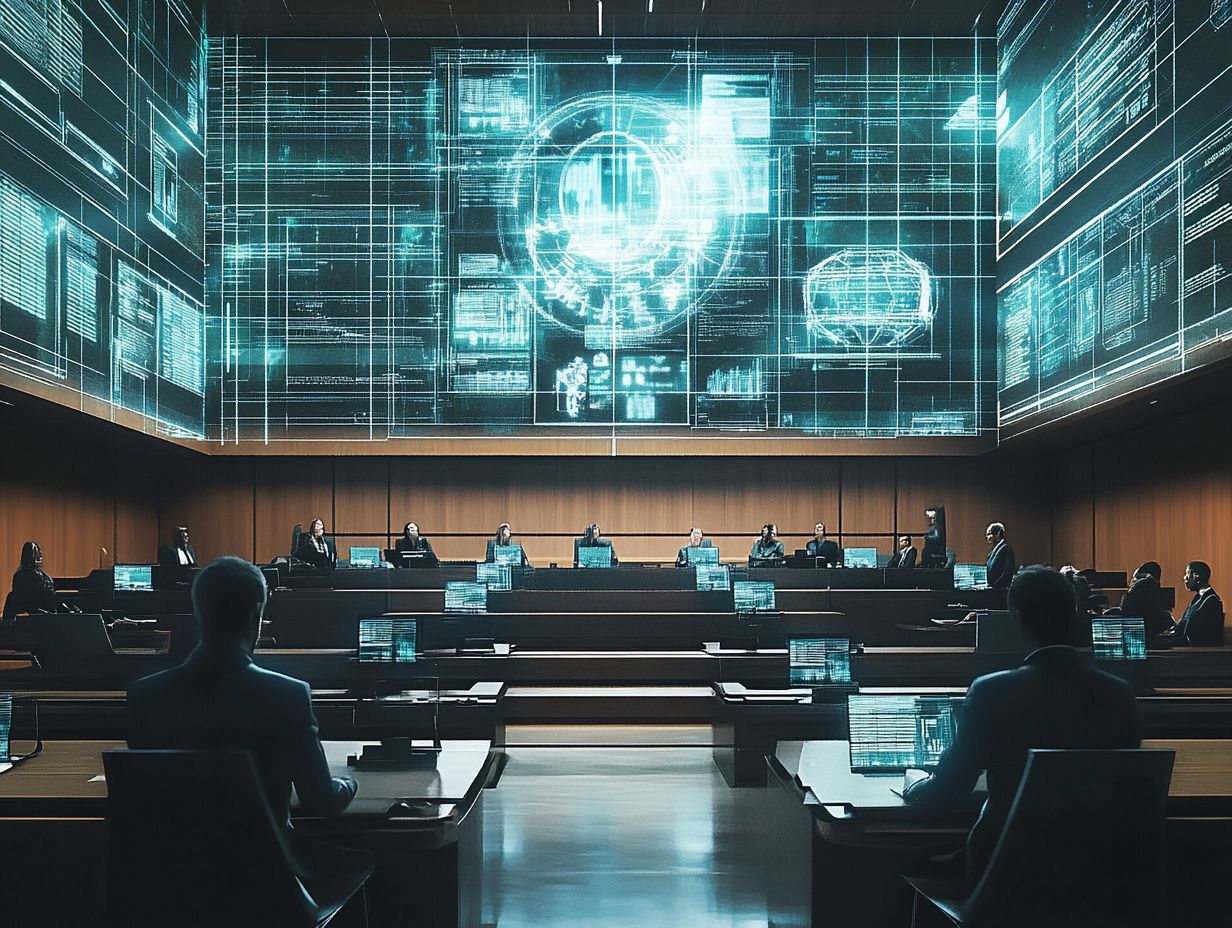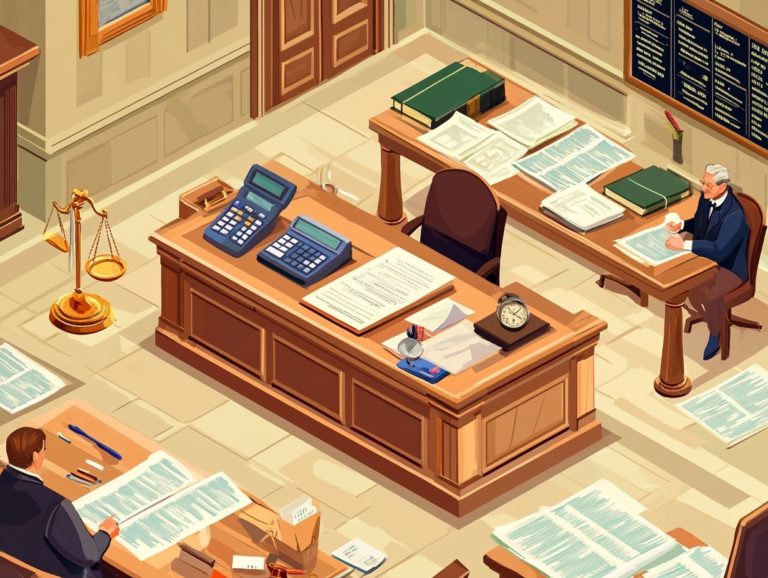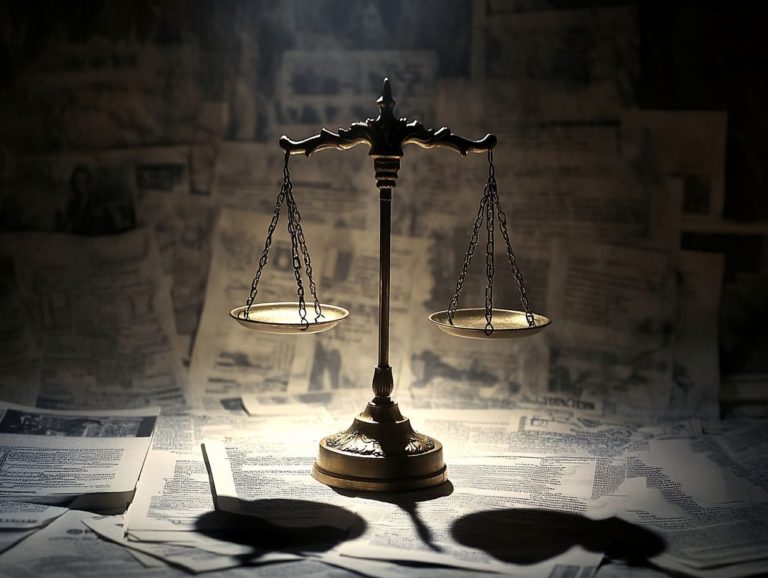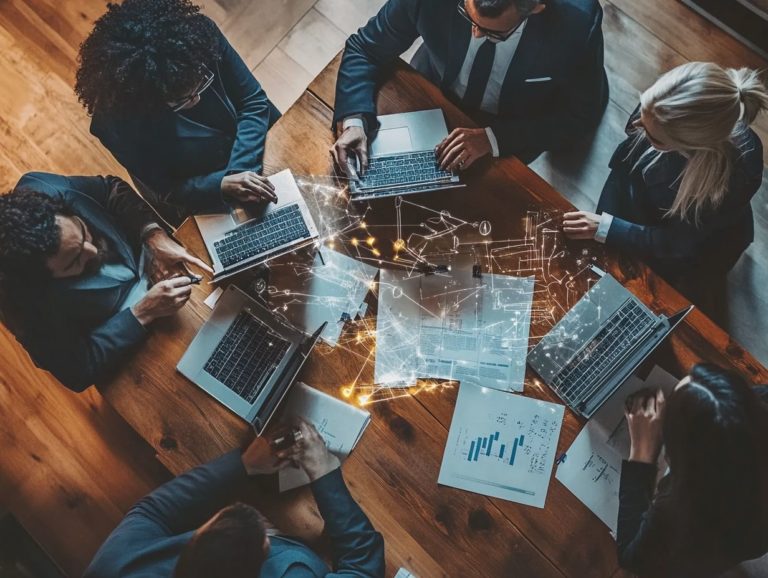5 Future Predictions for IP Litigation
The landscape of IP lawsuits is undergoing a swift transformation, driven by technological innovations and evolving legal frameworks.
Emerging trends are poised to significantly influence the future of IP disputes. With the advent of new technologies and a heightened emphasis on data privacy, these shifts are redefining case management.
This article delves into five critical predictions for the future of IP litigation, highlighting the challenges ahead and potential solutions that will affect lawyers, businesses, and innovators alike.
Contents
- Key Takeaways:
- 1. Increase in Patent Litigation Cases
- 2. Rise of Artificial Intelligence in IP Litigation
- 3. Greater Focus on Data Privacy and Security
- 4. Growth of Alternative Dispute Resolution Methods
- 5. Impact of Globalization on IP Litigation
- How Will IP Litigation Evolve in the Next Decade?
- Frequently Asked Questions
- Cu les son las 5 principales predicciones futuras para el litigio de propiedad intelectual (PI)?
- Tendr n los avances tecnol gicos un impacto en el litigio de PI en el futuro?
- C mo se centrar la protecci n de secretos comerciales en el litigio de PI?
- C mo contribuir la inteligencia artificial a los casos de infracci n de patentes?
- Se espera un cambio hacia m todos alternativos de resoluci n de disputas?
- Habr un aumento en las disputas globales de PI?
Key Takeaways:

IP litigation is expected to rise due to advancements in technology and globalization, emphasizing the need for strong and adaptable legal strategies.
The integration of artificial intelligence in IP litigation will revolutionize the legal process, increasing efficiency and accuracy.
Data privacy and security will be critical factors in IP litigation, leading to a greater focus on protection and compliance measures.
1. Increase in Patent Litigation Cases
In 2023, the landscape of patent litigation cases has escalated significantly, driven by recent legislative reforms that have transformed the judicial frameworks surrounding intellectual property rights in the United States.
This shift is clear with companies like Terves leading the charge for innovation, despite the challenges faced by various stakeholders in the industry.
This uptick is partly linked to new laws designed to streamline patent approval and enforcement, alongside noteworthy Supreme Court rulings that have clarified standards for patent eligibility.
Landmark decisions regarding software patents have set crucial precedents, prompting a wave of filings as companies strive to defend or assert their intellectual property with renewed vigor.
Such developments raise important questions for major players in the market whether inventors or technology firms about how to maintain competitive advantages while navigating the complex web of regulations and litigation.
The interplay between Congress and the judiciary continues to shape the patent landscape, influencing innovation and impacting the broader economy.
2. Rise of Artificial Intelligence in IP Litigation
The rise of artificial intelligence in IP litigation presents both challenges and opportunities, especially as generative AI technologies reshape how companies approach legal compliance and governance.
As you adopt AI tools for tasks such as contract analysis and infringement detection, you enhance the efficiency of your legal processes.
Automated systems can sift through vast datasets to identify patterns and potential risks, delivering insights that previously demanded significant time and effort.
However, this transformation brings considerable legal implications, particularly regarding the ownership of AI-generated content and ethical responsibilities in using these technologies for IP management.
Navigating this evolving landscape requires staying informed about regulatory changes and contemplating how AI’s integration might shift legal strategies and risk assessments.
3. Greater Focus on Data Privacy and Security
As you increasingly rely on digital assets, the focus on data privacy and security intensifies. This prompts a reevaluation of compliance strategies to enhance sustainability and protect economic value.
This shift carries significant implications for IP litigation. You must safeguard proprietary information while navigating the complex regulations governing data use and protection.
Ensuring compliance with evolving standards becomes essential as the legal landscape shifts around online data collection and consumer rights.
For your organization, understanding the intersection of IP and data privacy can mean the difference between gaining a competitive edge and facing costly legal disputes.
This is a crucial issue you need to address in today s digitally-driven economy!
Stay informed to safeguard your innovations in this evolving landscape!
4. Growth of Alternative Dispute Resolution Methods

Alternative dispute resolution methods are on the rise, signifying a remarkable transformation in how stakeholders engage with litigation. This trend highlights a focus on efficiency and collaboration in addressing intellectual property disputes.
These methods streamline the resolution process and minimize the costs tied to drawn-out legal battles. By fostering open communication in a relaxed setting, you can pinpoint shared interests and arrive at mutually beneficial agreements.
As the intricacies of intellectual property law continue to evolve, these approaches offer a flexible framework that adapts to the distinct needs of each case. Embracing alternative dispute resolution can significantly alleviate the burden on courts, ultimately enhancing the effectiveness of the legal system in managing IP conflicts.
5. Impact of Globalization on IP Litigation
Globalization has significantly transformed IP litigation, as you navigate a variety of legal landscapes and seek market insights to adapt to ever-evolving trends and governance challenges across international jurisdictions.
This shift has led to a surge in cross-border disputes disputes that occur between businesses in different countries urging you to adopt a more strategic approach to intellectual property management.
Consider the case of a prominent technology giant facing allegations in multiple countries over patent infringements; this scenario underscores the challenges posed by different legal systems.
As a multinational company, you often find yourself balancing diverse enforcement standards and legal interpretations that directly influence your business strategies.
In this context, the need for effective governance becomes essential. You must develop robust legal frameworks that adapt to the intricacies of international law while optimizing your outreach and innovation strategies.
How Will IP Litigation Evolve in the Next Decade?
As you look towards the next decade, it s clear that IP litigation is on the brink of significant evolution, influenced by emerging trends in technology, innovation, and sustainability. These changes will reshape how rights are enforced and how the economic value of intellectual property is realized.
With the rise of artificial intelligence and blockchain, the landscape of IP protection is becoming increasingly intricate. You, along with businesses and legal professionals, will face a myriad of challenges, such as defining ownership rights in AI-generated content and ensuring compliance with decentralized systems.
These technological advancements may introduce new forms of infringement, prompting a critical reevaluation of existing legal frameworks. To stay ahead, you must adapt by investing in ongoing education and developing robust strategies that integrate technology while safeguarding your innovations. Embrace the latest technologies now! They will be crucial for staying ahead in this competitive landscape.
What Are the Current Trends in IP Litigation?
Current trends in IP litigation highlight the rapid pace of digitalization and the growing complexity of compliance requirements, urging you to reevaluate your strategies for safeguarding intellectual property rights.
As you navigate a landscape where innovation collides with regulatory scrutiny, you’ll notice that litigation surrounding intellectual property is becoming more frequent, especially in industries like technology, where new products race to market, often sparking disputes over ownership and patent rights.
To adapt, companies like yours are embracing more sophisticated legal approaches, opting for proactive measures such as comprehensive monitoring and strategic alliances rather than reactive litigation.
In this shifting environment, challenges related to digital compliance are becoming increasingly evident. You must find a careful balance between your growth ambitions and the necessity of adhering to evolving legal frameworks.
Stay informed about these changes to protect your IP effectively.
What Are the Key Factors Driving Changes in IP Litigation?

Key factors driving changes in IP litigation involve shifts in legislation, rapid advancements in innovation, and evolving industry standards that compel you to adapt your approach to managing intellectual property rights.
Global economic conditions and increasing market interconnectivity also play a role. As new technologies emerge at a breathtaking pace, traditional legal frameworks often struggle to keep up. This leads to uncertainty for companies eager to protect their innovations.
You, along with businesses, legal practitioners, and policymakers, must navigate this complex landscape. Stay informed about recent reforms and technological developments. By proactively engaging in dialogue and leveraging available resources, you can better strategize your intellectual property management and ensure compliance with evolving regulations.
This adaptability will ultimately position you favorably in an increasingly competitive environment.
How Will the Role of Intellectual Property Lawyers Change?
The role of intellectual property lawyers is poised for a significant transformation as you adapt to emerging trends in litigation, technology, and industry demands. This requires a more dynamic approach to your legal practice.
As digital innovations and AI reshape the intellectual property landscape, you must cultivate a nuanced understanding of these new technologies and their implications for IP rights. Strategies that once served you well may soon become outdated.
Continuous education in areas like data analytics and cybersecurity will be essential. With the rise of cross-border issues and global collaborations, heightened expertise in international law will be crucial.
Honing your communication skills and adopting an agile mindset will be vital for effectively navigating this ever-evolving landscape of intellectual property law.
What Are the Potential Challenges for IP Litigation in the Future?
Future challenges in IP litigation will require you to navigate complexities introduced by AI technologies that create content, ensure compliance with evolving regulations, and enhance efficiency in legal processes.
As you integrate these advanced technologies into your operations, expect to encounter hurdles that could disrupt traditional notions of intellectual property rights. You ll need to adapt to the rapid pace of innovation, which may outstrip existing legal frameworks.
This could lead to uncertainties around ownership and copyright. Identifying and protecting your proprietary assets from potential infringements caused by AI-generated content will become increasingly challenging.
Stay proactive. Keep informed about changes in intellectual property laws and their implications for your strategies.
What Are the Possible Solutions to Address These Challenges?
To tackle the challenges of IP litigation, consider the benefits of enhanced collaboration among industry stakeholders, robust governance frameworks, and innovative legal practices designed to streamline processes.
By fostering partnerships between legal firms, tech companies, and regulatory bodies, you can help create a more cohesive approach to resolving disputes.
Integrating technology like AI will enable you to analyze vast amounts of data, improving efficiency and shortening the duration of litigation.
Establishing clear guidelines and best practices will enhance governance, ensuring all parties remain aligned in their objectives.
Through these collaborative and innovative strategies, you can achieve a more effective and streamlined IP litigation process, benefiting both creators and users of intellectual property.
Frequently Asked Questions

Cu les son las 5 principales predicciones futuras para el litigio de propiedad intelectual (PI)?
Las 5 principales predicciones incluyen un aumento en los litigios por avances tecnol gicos. Tambi n se espera un mayor nfasis en la protecci n de secretos comerciales y un incremento en casos de infracci n de patentes, especialmente relacionados con inteligencia artificial.
Tendr n los avances tecnol gicos un impacto en el litigio de PI en el futuro?
S , los avances tecnol gicos, como blockchain e inteligencia artificial, cambiar n el panorama del litigio de PI. Con estas innovaciones, es probable que veamos un aumento en disputas sobre patentes y derechos de autor.
C mo se centrar la protecci n de secretos comerciales en el litigio de PI?
La protecci n de secretos comerciales ser esencial en el litigio de PI debido a la creciente importancia de la informaci n en la era digital. Las empresas est n aumentando su vigilancia, lo que podr a resultar en m s casos de apropiaci n indebida.
C mo contribuir la inteligencia artificial a los casos de infracci n de patentes?
La inteligencia artificial se volver un factor clave en las disputas de patentes a medida que se integre en m s industrias. Esto generar debates sobre la propiedad de algoritmos y procesos innovadores.
Se espera un cambio hacia m todos alternativos de resoluci n de disputas?
S , se anticipa un cambio hacia m todos como la mediaci n y el arbitraje. Estos enfoques son m s rentables y eficientes en comparaci n con los litigios tradicionales.
Habr un aumento en las disputas globales de PI?
Se prev un auge en las disputas globales de PI, impulsado por mercados en expansi n y la facilidad de transacciones internacionales. Esto crear una necesidad urgente de cooperaci n y entendimiento de las leyes de PI en diferentes pa ses.






